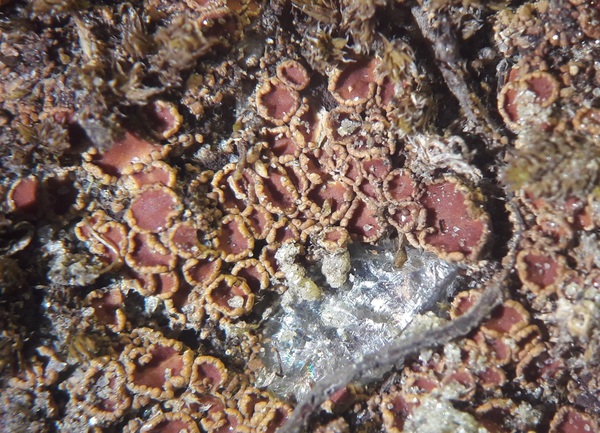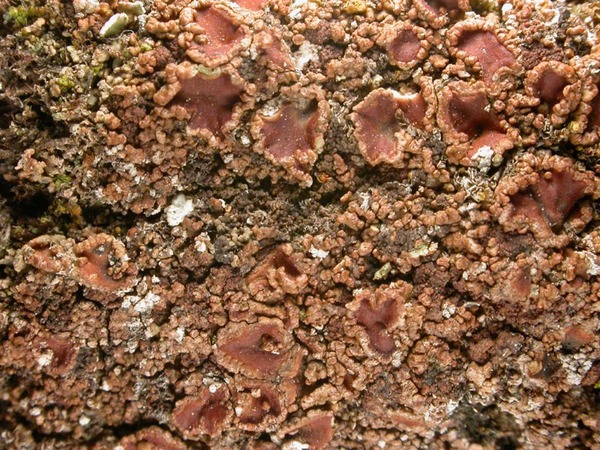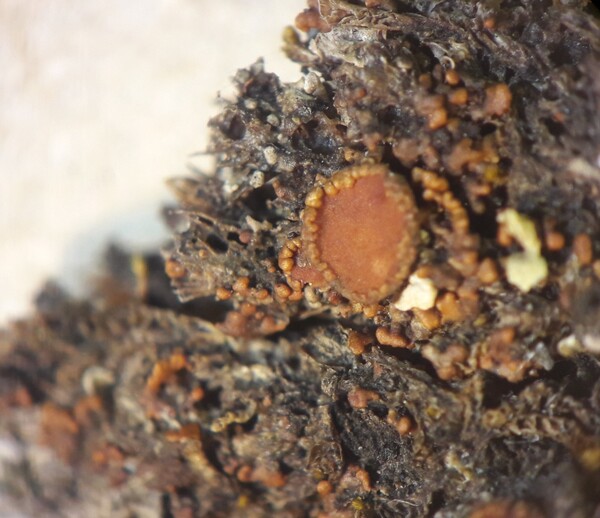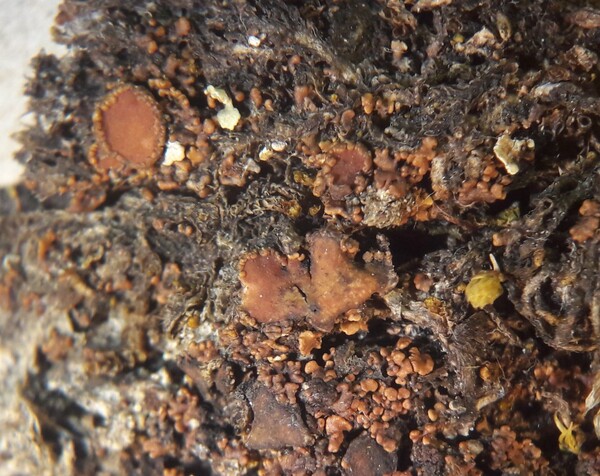Psoroma tenue Henssen var. boreale Henssen
in Henssen & Renner, Mycotaxon, 13: 441, 1981.
Synonyms:
Description: Thallus crustose to subsquamulose, cinnamon brown (with an orange hue) when dry, green when wet, strongly glossy, with interspersed blackish brown granules (cephalodia). Squamules globose, often aggregated, up to 0.4 mm wide and 150-300 µm thick. Cephalodia granular to branched-coralloid, up to 0.8 mm wide, corticate by one or two rows of cells. Upper cortex paraplectenchymatous, 20-25(-30) µm thick; medulla white, of loosely reticulate hyphae; lower cortex occasionally developed, paraplectenchymatous, 30-40 µm thick. Apothecia lecanorine, to 2 mm across, with a mostly flat, brown to dark brown disc, and a granular thalline margin. Epithecium brown; hymenium colourless, 90-120 µm high, I+ dark blue; paraphyses simple, the apical cells not swollen; hypothecium colourless or almost so, often extending into a stipe towards the base. Asci 8-spored, narrowly ellipsoid or cylindrical, the apex with a K/I+ deep blue central tube in a paler-staining tholus, and an internal, K/I+ dark blue ring-structure. Ascospores 1-celled, hyaline, ovoid, 19-22(-24) x 7-12 µm, with a warted-ridged epispore. Pycnidia rare, small, pale brown. Conidia bacilliform, 2-4 x c. 1 µm. Photobiont chlorococcoid in thallus, cyanobacterial (Nostoc) in cephalodia. Spot tests: K-, C-, KC-, P-, UV-. Chemistry: thallus and apothecia with pannaric acid, porphyrilic acid methyl ester and a related unknown substance.
Growth form: Crustose
Substrata: soil, terricolous mosses, and plant debris
Photobiont: green algae other than Trentepohlia
Reproductive strategy: mainly sexual
Commonnes-rarity: (info)
Alpine belt: rather common
Subalpine belt: very rare
Montane belt: absent
Dry submediterranean belt: absent
Humid submediterranean belt: absent
Padanian area: absent
pH of the substrata:
1 2 3 4 5
Solar irradiation:
1 2 3 4 5
Aridity:
1 2 3 4 5
Eutrophication:
1 2 3 4 5
Poleotolerance:
0 1 2 3
Altitudinal distribution:
1 2 3 4 5 6
Rarity
absent
extremely rare
very rare
rare
rather rare
rather common
common
very common
extremely common
Loading data...
Occurrence data
Predictive map
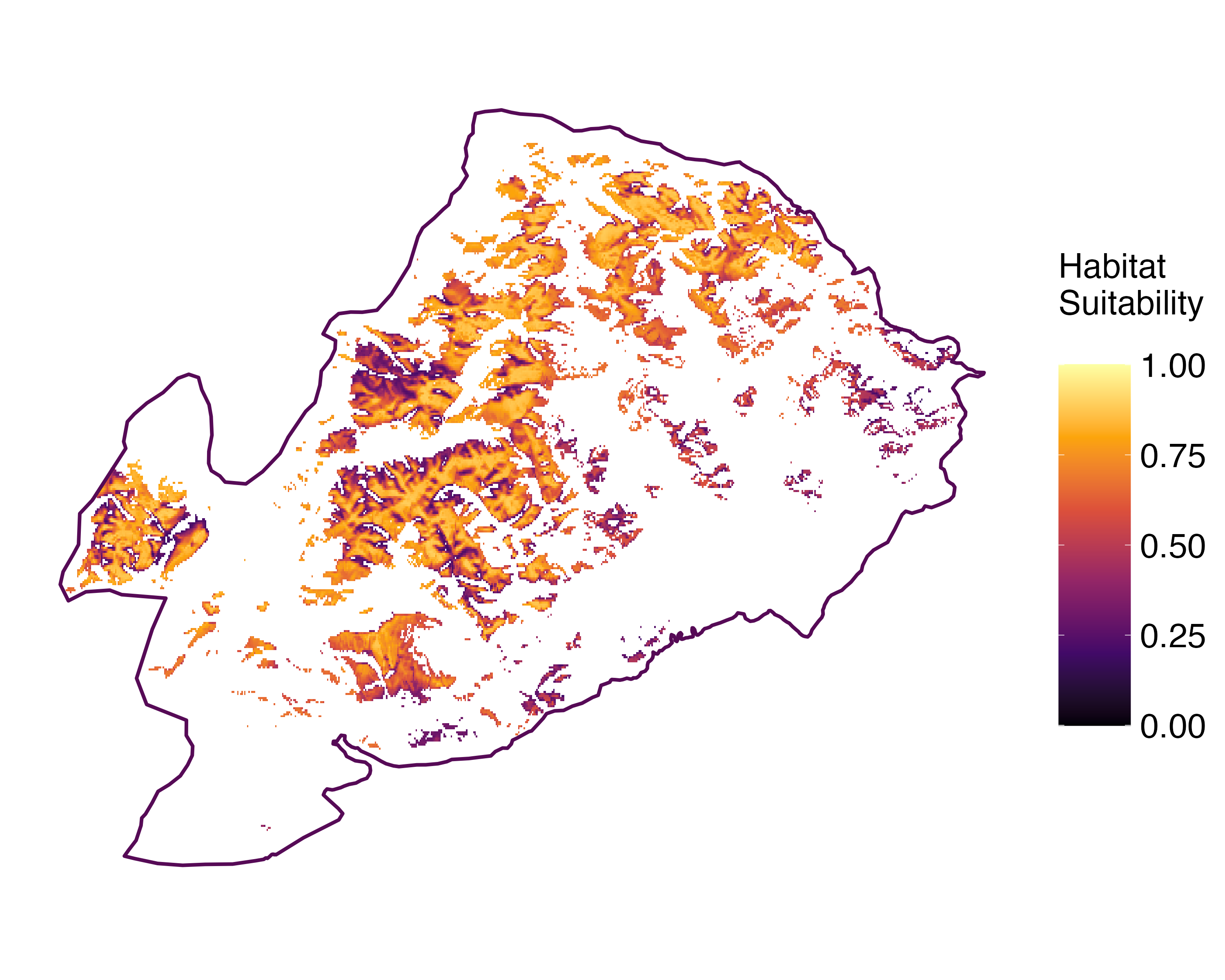 Current prediction (1981-2010)
Current prediction (1981-2010) Future prediction (2071-2100) SSP 1-2.6
Future prediction (2071-2100) SSP 1-2.6 Future prediction (2071-2100) SSP 5-8.5Predictive maps according to Francesconi et al. 2025
Future prediction (2071-2100) SSP 5-8.5Predictive maps according to Francesconi et al. 2025
Growth form: Crustose
Substrata: soil, terricolous mosses, and plant debris
Photobiont: green algae other than Trentepohlia
Reproductive strategy: mainly sexual
Commonnes-rarity: (info)
Alpine belt: rather common
Subalpine belt: very rare
Montane belt: absent
Dry submediterranean belt: absent
Humid submediterranean belt: absent
Padanian area: absent
pH of the substrata:
| 1 | 2 | 3 | 4 | 5 |
Solar irradiation:
| 1 | 2 | 3 | 4 | 5 |
Aridity:
| 1 | 2 | 3 | 4 | 5 |
Eutrophication:
| 1 | 2 | 3 | 4 | 5 |
Poleotolerance:
| 0 | 1 | 2 | 3 |
Altitudinal distribution:
| 1 | 2 | 3 | 4 | 5 | 6 |
Rarity
absent
extremely rare
very rare
rare
rather rare
rather common
common
very common
extremely common
Loading data...
Occurrence data
Predictive map
 Current prediction (1981-2010)
Current prediction (1981-2010) Future prediction (2071-2100) SSP 1-2.6
Future prediction (2071-2100) SSP 1-2.6 Future prediction (2071-2100) SSP 5-8.5
Future prediction (2071-2100) SSP 5-8.5Predictive maps according to Francesconi et al. 2025


